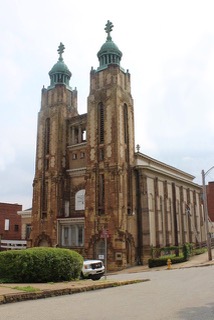Rusyn Americans
Rusyn Americans are Americans of Rusyn descent. The Rusyns, also known as Ruthenians in historical contexts, are a Slavic ethnic group primarily living in the Carpathian Mountains of Eastern Europe, straddling the borders of modern-day Slovakia, Poland, Ukraine, and Hungary. Unlike other Slavic nations, Rusyns have not had their own independent nation-state and have been part of various countries throughout history. This article explores the migration, communities, and cultural contributions of Rusyn Americans within the United States.
Migration and Settlement[edit | edit source]
The first significant wave of Rusyn immigration to the United States occurred in the late 19th and early 20th centuries. This migration was primarily driven by economic hardship, lack of arable land, and political oppression in the Austro-Hungarian Empire. Many Rusyns settled in the industrial regions of the Northeast, the Midwest, and parts of Pennsylvania, where they found work in coal mines, steel mills, and factories. These early immigrants established tight-knit communities that sought to preserve their unique language, Eastern Orthodox and Greek Catholic faiths, and cultural traditions.
Cultural Contributions[edit | edit source]
Rusyn Americans have made significant contributions to the cultural tapestry of the United States, particularly in the realms of religious life, cuisine, and the arts. They have been instrumental in establishing Eastern Orthodox and Greek Catholic churches, which serve as community hubs. Traditional Rusyn cuisine, with dishes like pierogi and halushki, has found a place in American culinary diversity. In the arts, Rusyn Americans have contributed to music, dance, and the visual arts, often showcasing their rich folk traditions and history through these mediums.
Preservation of Heritage[edit | edit source]
In an effort to preserve their cultural heritage, Rusyn Americans have established various organizations and institutions. These include cultural foundations, dance ensembles, and language classes that aim to keep the Rusyn language and traditions alive among younger generations. Additionally, academic research and publications have played a crucial role in documenting the history and cultural practices of the Rusyn people in both the United States and Europe.
Notable Rusyn Americans[edit | edit source]
Several Rusyn Americans have gained prominence in various fields, including politics, sports, and the arts. Their achievements have not only contributed to their communities but have also highlighted the Rusyn American presence within the broader American society.
Challenges[edit | edit source]
Despite their contributions, Rusyn Americans face challenges related to identity and recognition. The Rusyn identity is often overshadowed by broader Slavic identities, and there is a continuous effort among Rusyn Americans to assert their distinct heritage and culture. Additionally, assimilation and the fading of first-generation traditions pose challenges to the preservation of Rusyn cultural identity.
Conclusion[edit | edit source]
Rusyn Americans, with their rich cultural heritage and history of migration, have contributed significantly to the multicultural landscape of the United States. Through their efforts to preserve their unique identity and traditions, they continue to enrich the American cultural mosaic.
This article is a ethnic-group stub. You can help WikiMD by expanding it!
Search WikiMD
Ad.Tired of being Overweight? Try W8MD's physician weight loss program.
Semaglutide (Ozempic / Wegovy and Tirzepatide (Mounjaro / Zepbound) available.
Advertise on WikiMD
|
WikiMD's Wellness Encyclopedia |
| Let Food Be Thy Medicine Medicine Thy Food - Hippocrates |
Translate this page: - East Asian
中文,
日本,
한국어,
South Asian
हिन्दी,
தமிழ்,
తెలుగు,
Urdu,
ಕನ್ನಡ,
Southeast Asian
Indonesian,
Vietnamese,
Thai,
မြန်မာဘာသာ,
বাংলা
European
español,
Deutsch,
français,
Greek,
português do Brasil,
polski,
română,
русский,
Nederlands,
norsk,
svenska,
suomi,
Italian
Middle Eastern & African
عربى,
Turkish,
Persian,
Hebrew,
Afrikaans,
isiZulu,
Kiswahili,
Other
Bulgarian,
Hungarian,
Czech,
Swedish,
മലയാളം,
मराठी,
ਪੰਜਾਬੀ,
ગુજરાતી,
Portuguese,
Ukrainian
Medical Disclaimer: WikiMD is not a substitute for professional medical advice. The information on WikiMD is provided as an information resource only, may be incorrect, outdated or misleading, and is not to be used or relied on for any diagnostic or treatment purposes. Please consult your health care provider before making any healthcare decisions or for guidance about a specific medical condition. WikiMD expressly disclaims responsibility, and shall have no liability, for any damages, loss, injury, or liability whatsoever suffered as a result of your reliance on the information contained in this site. By visiting this site you agree to the foregoing terms and conditions, which may from time to time be changed or supplemented by WikiMD. If you do not agree to the foregoing terms and conditions, you should not enter or use this site. See full disclaimer.
Credits:Most images are courtesy of Wikimedia commons, and templates, categories Wikipedia, licensed under CC BY SA or similar.
Contributors: Prab R. Tumpati, MD

